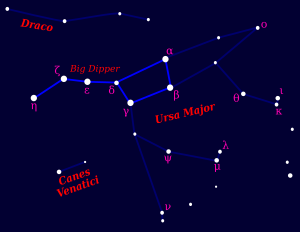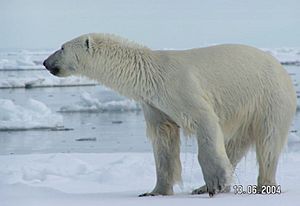Ursa Major facts for kids
| Constellation | |

List of stars in Ursa Major
|
|
| Abbreviation | UMa |
|---|---|
| Genitive | Ursae Majoris |
| Pronunciation | genitive |
| Symbolism | the Great Bear |
| Right ascension | 10.67 |
| Declination | +55.38 |
| Quadrant | NQ2 |
| Area | 1280 sq. deg. (3rd) |
| Main stars | 7, 20 |
| Bayer/Flamsteed stars |
93 |
| Stars with planets | 20 |
| Stars brighter than 3.00m | 7 |
| Stars within 10.00 pc (32.62 ly) | 8 |
| Brightest star | ε UMa (Alioth) (1.76m) |
| Messier objects | 7 |
| Meteor showers | Alpha Ursa Majorids Leonids-Ursids |
| Bordering constellations |
Draco Camelopardalis Lynx Leo Minor Leo Coma Berenices Canes Venatici Boötes |
| Visible at latitudes between +90° and −30°. Best visible at 21:00 (9 p.m.) during the month of April. The Big Dipper or Plough. |
|
Ursa Major is a large constellation you can see in the northern hemisphere and parts of the southern hemisphere. Its name means Great Bear in Latin. Many cultures around the world have thought its stars look like a bear with a long tail. It is often used as a symbol for north.
Contents
What is Ursa Major?
Ursa Major is one of the biggest constellations in the night sky. It covers a large area and is easy to find. People have used it for thousands of years to help them find their way.
Stars and Deep-Sky Objects
Ursa Major has many interesting things to see, even with a small telescope. It is home to several bright galaxies, which are huge groups of stars, gas, and dust.
- Two of the brightest galaxies are Messier 81 and Messier 82. They are located above the bear's head.
- The Pinwheel galaxy (M101) is a beautiful spiral galaxy. You can find it northwest of the star η Ursae Majoris.
- Other well-known spiral galaxies include NGC 4102, NGC 4605, Messier 108, and Messier 109.
- The constellation has about 50 galaxies that you can see with a small telescope.
- The Owl nebula is the brightest planetary nebula in the constellation. A nebula is a cloud of gas and dust in space. You can find the Owl Nebula along the bottom of the Big Dipper's "bowl."
The Big Dipper: A Famous Star Pattern
The seven brightest stars in Ursa Major form a famous pattern called the Big Dipper. In Great Britain, it is known as the Plough. This group of stars is one of the most recognized patterns in the sky. Almost everyone who lives where it can be seen knows it.
The Big Dipper is very helpful for finding the North Star. If you draw an imaginary line through the two stars on the right side of the Dipper, it will point directly to the North Star. These two stars are called The Pointers. They are very important for navigation using stars.
Most of the stars in the Big Dipper are moving together through space. This group of stars is called the Ursa Major Moving Group. Only two stars, Dubhe and Alkaid, are not part of this group.
Stories and Myths About Ursa Major
Many different cultures have told stories about the Ursa Major constellation. Often, they saw it as a bear, usually a female bear. These stories might come from very old traditions about hunting in the sky.
Ancient Greek and Roman Stories
In Greek mythology, Zeus, the king of the gods, fell in love with a young woman named Callisto. She was a nymph, a nature spirit, who followed the goddess Artemis. Zeus's wife, Hera, became very jealous. When Callisto had Zeus's son, Arcas, Hera turned Callisto into a bear as punishment.
Later, Callisto, in her bear form, met her son Arcas. Arcas almost speared the bear, not knowing it was his mother. To stop this tragedy, Zeus quickly placed both Callisto and Arcas in the sky. Callisto became Ursa Major, and Arcas became the constellation Boötes. The poet Ovid called Ursa Major the "Parrhasian Bear" because Callisto came from Parrhasia.
The Greek poet Aratus called the constellation "Helike," meaning "turning" or "twisting." This is because it seems to turn around the North Star. The ancient Greek epic poem Odyssey mentions that it is the only constellation that never sets below the horizon. This made it a useful guide for sailors. It was also called the "Wain" or "Plaustrum," which is a Latin word for a horse-drawn cart.
Hindu Traditions
In Hinduism, Ursa Major is known as Saptarshi. Each of its stars represents one of the seven great sages (Rishis): Bhrigu, Atri, Angiras, Vasishtha, Pulastya, Pulaha, and Kratu. The story explains that the two front stars of the constellation point to the North Star because of a blessing given to a young sage named Dhruva by Lord Vishnu.
East Asian Traditions
In China and Japan, the Big Dipper is called the "North Dipper" (běidǒu in Chinese, hokuto in Japanese). In ancient times, each of the seven stars had a special name:
- "Pivot" is for Dubhe (Alpha Ursae Majoris).
- "Beautiful jade" is for Merak (Beta Ursae Majoris).
- "Pearl" is for Phecda (Gamma Ursae Majoris).
- "Balance" is for Megrez (Delta Ursae Majoris).
- "Measuring rod of jade" is for Alioth (Epsilon Ursae Majoris).
- "Opening of the Yang" is for Mizar (Zeta Ursae Majoris).
- Alkaid (Eta Ursae Majoris) had several nicknames, like "Sword" or "Flickering light." One nickname was "Star of military defeat" because traveling in its direction was thought to bring bad luck to an army.
In Shinto, the seven largest stars of Ursa Major belong to Ame-no-Minakanushi. This is the oldest and most powerful of all kami (gods or spirits).
In South Korea, the constellation is called "the seven stars of the north." A myth tells of a widow with seven sons. To reach a widower's house, they had to cross a stream. The sons placed stepping stones in the river for their mother. She blessed them, and when they died, they became the constellation.
Native American Traditions
The Iroquois people saw Alioth, Mizar, and Alkaid as three hunters chasing the Great Bear. In one story, the first hunter (Alioth) carries a bow and arrow. The second hunter (Mizar) carries a large pot (the star Alcor) to cook the bear. The third hunter (Alkaid) carries firewood for the fire.
The Lakota people call the constellation Wičhákhiyuhapi, or "Great Bear." The Wampanoag people called Ursa Major "maske," meaning "bear." The Wasco-Wishram Native Americans believed the constellation was 5 wolves and 2 bears left in the sky by Coyote.
Germanic Traditions
To Norse pagans, the Big Dipper was known as Óðins vagn, which means "Woden's wagon." Woden was also called "guardian of the wagon" or "confidant of the wagon" in their poems.
Uralic Traditions
In Finnish, the Big Dipper is sometimes called Otava. This old name means a salmon weir, a trap for fish. Ancient Finns believed the bear was lowered to Earth in a golden basket from Ursa Major. When a bear was killed, its head was placed on a tree so its spirit could return to Ursa Major.
In the Sámi languages of Northern Europe, part of the constellation (the Big Dipper without Dubhe and Merak) is seen as the bow of a great hunter named Fávdna. The star Arcturus is Fávdna. In the main Sámi language, North Sámi, it is called Fávdnadávgi ("Fávdna's Bow") or simply dávggát ("the Bow"). The Bow is important in Sámi stories about the night sky. Various hunters try to chase Sarva, the Great Reindeer, a large constellation that takes up almost half the sky. Fávdna is ready to fire his Bow every night but hesitates. He fears he might hit Stella Polaris, known as Boahji ("the Rivet"). If he hit it, the sky would collapse, and the world would end.
Southeast Asian Traditions
In Burmese, Pucwan Tārā is the name for a constellation that includes stars from the head and front legs of Ursa Major. Pucwan is a general term for crustaceans like prawns, shrimp, crabs, or lobsters.
In Javanese, it is known as "lintang jong," meaning "the jong constellation" (a type of ship). Similarly, in Malay, it is called "bintang jong."
How Ursa Major is Pictured
In old European star charts, the "square" of the Big Dipper formed the bear's body. The "handle" of the Dipper was shown as a long tail. However, real bears do not have long tails! Some Jewish astronomers thought Alioth, Mizar, and Alkaid were three cubs following their mother. Native Americans saw them as three hunters.
The children's book author H. A. Rey had a different idea for how Ursa Major could look. In his 1952 book The Stars: A New Way to See Them, he drew the constellation so that Alkaid was the tip of the bear's nose. The "handle" of the Big Dipper formed the outline of the bear's head and neck, leading back to its shoulder. This way, it looked more like a polar bear with a longer head and neck.
Ursa Major in Flags and Art
Ursa Major has appeared in many flags and works of art:
- The Starry Plough is an Irish flag adopted in 1916. It shows the constellation on a blue background.
- The constellation is also on the state flag of Alaska.
- It appears on the House of Bernadotte's version of the coat of arms of Sweden.
- The seven stars on a red background of the flag of the Community of Madrid, Spain, might be the stars of the Plough.
- The same seven stars are pictured in the blue border of the coat of arms of Madrid, the capital of Spain.
Images for kids
-
Ursa Major shown on a carved stone, c.1700, Crail, Fife
See also
 In Spanish: Osa Mayor para niños
In Spanish: Osa Mayor para niños







